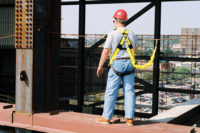It’s not news that falls from height cause the majority of work-related fatalities among residential construction workers (64 percent, according to a 2011 report by the BLS).
 There are lots of different types of fall protection available to the industry, yet workers still frequently work at height without fall protection.
There are lots of different types of fall protection available to the industry, yet workers still frequently work at height without fall protection.
An article in the July issue of Professional Safety - the American Society of Safety Engineers’ (ASSE) journal explores the options available and delves into why contractors are slow to implement them.
Carpenters, safety pros and contractors surveyed
Vicki Kaskutas, Bradley Evanoff and Harry Miller, the authors of Fall Protection on Residential Construction Sites, report on a pilot study that identifies fall protection technologies, measures a small sample of carpentry professionals’ perceptions of these technologies and pilot tests two devices with several residential contractors. Groups surveyed consisted of apprentice carpenters, journeymen carpenters, safety professionals and contractor owners/operators.
The study showed that many commercially available fall protection solutions for three separate categories:
- floor openings
- temporary walking surfaces
- personal fall arrest anchorage
How will fall protection affect productivity?
One concern on the part of contractors: how the time to train a worker on fall protection – and put the device into use – will affect productivity.
“There is a learning curve when using a new fall protection device; this can add time to the home building process, which is a major concern in the current economic environment,” explained Kaskutsas.
In addition, safe and feasible points to anchor a harness do not exist during some stages of home construction, particularly during framing. Other obstacles include resistance to changing work habits; and the lack of time, knowledge and financial resources to implement available options.
“The study was done several years ago, and was meant to catalogue all of the fall protection technologies out there, show some new innovations, get construction professionals opinions, and test a few of these devices” Kaskutas said.
Overcoming the obstacles
Fall Protection in Residential Construction identifies different solutions to overcoming these obstacles to use, such as:
- repetitive use of a device to lead to long term adoption of fall protection technologies
- loaning of pilot-tested equipment to contractors to allow them to integrate it into their workplaces before they purchase it
- fall protection equipment rental companies that may be able to help contractors identify and locate the best equipment for a contractors situation.
Click here for information about ASSE’s Professional Safety journal.


